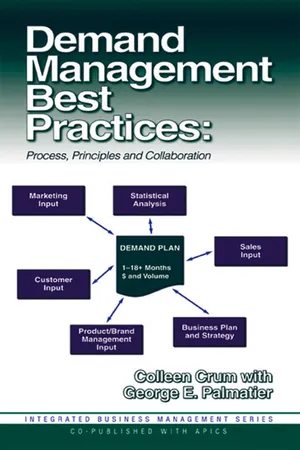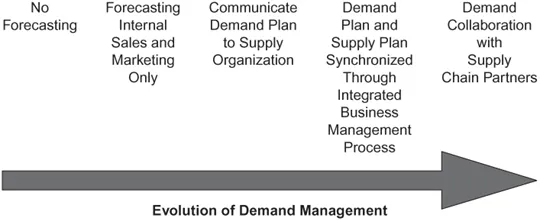
eBook - ePub
Demand Management Best Practices
Process, Principles, and Collaboration
- 256 pages
- English
- ePUB (mobile friendly)
- Available on iOS & Android
eBook - ePub
Demand Management Best Practices
Process, Principles, and Collaboration
About this book
Demand Management Best Practices outlines an effective demand management model process tied to an integrated business process that will give your organization a competitive edge. The book helps you effectively respond to ever-increasing expectations for improved supplier delivery performance, product availability, and responsiveness and ongoing pressure from shareholders and stock market analysts to produce promised sales revenue and profit margins. It presents solutions for improving overall business performance for the end-to-end supply chain, shows you where to focus your time and attention to improve demand management processes, and discusses what results to expect. The authors provide insights on how to apply best practices in developing a forecast and demand plan, reducing uncertainty of demand, reaching consensus internally, and collaborating with customers and suppliers within the supply chain.
Frequently asked questions
Yes, you can cancel anytime from the Subscription tab in your account settings on the Perlego website. Your subscription will stay active until the end of your current billing period. Learn how to cancel your subscription.
No, books cannot be downloaded as external files, such as PDFs, for use outside of Perlego. However, you can download books within the Perlego app for offline reading on mobile or tablet. Learn more here.
Perlego offers two plans: Essential and Complete
- Essential is ideal for learners and professionals who enjoy exploring a wide range of subjects. Access the Essential Library with 800,000+ trusted titles and best-sellers across business, personal growth, and the humanities. Includes unlimited reading time and Standard Read Aloud voice.
- Complete: Perfect for advanced learners and researchers needing full, unrestricted access. Unlock 1.4M+ books across hundreds of subjects, including academic and specialized titles. The Complete Plan also includes advanced features like Premium Read Aloud and Research Assistant.
We are an online textbook subscription service, where you can get access to an entire online library for less than the price of a single book per month. With over 1 million books across 1000+ topics, we’ve got you covered! Learn more here.
Look out for the read-aloud symbol on your next book to see if you can listen to it. The read-aloud tool reads text aloud for you, highlighting the text as it is being read. You can pause it, speed it up and slow it down. Learn more here.
Yes! You can use the Perlego app on both iOS or Android devices to read anytime, anywhere — even offline. Perfect for commutes or when you’re on the go.
Please note we cannot support devices running on iOS 13 and Android 7 or earlier. Learn more about using the app.
Please note we cannot support devices running on iOS 13 and Android 7 or earlier. Learn more about using the app.
Yes, you can access Demand Management Best Practices by Colleen Crum,George Palmatier in PDF and/or ePUB format, as well as other popular books in Business & Operations. We have over one million books available in our catalogue for you to explore.
Information

INTRODUCTION
Thirty years ago, demand management within most manufacturing companies was minimal at best or nonexistent. In some cases, demand was forecast, but it was not common for the forecast to be used to drive financial projections or production rates. Only in rare circumstances was demand information communicated by customers to their suppliers.
Today, companies and supply chains are developing whole new models for managing demand. Companies are using the demand plan to drive their supply and financial plans, which is causing demand plans to be updated monthly, rather than quarterly or annually. Customers and suppliers are collaborating to communicate demand information (monthly, weekly, and even in near real time) and develop tactics to capture sales.
As a result, the roles, responsibilities, and best practices of demand management are changing and continuing to evolve. The purpose of this book is to document the principles and best practices of demand management. It focuses not only on today's best practices but on what the authors believe will be the best practices of the future. In doing so, we hope that you will not have to “reinvent the wheel” in implementing demand management in your company and supply chain. We also hope that the experiences and practices presented in this book will stimulate your company, and the supply chains in which you are a partner, to continue to improve your demand management processes.
Today, there is a greater realization of the value of — and need for — competency in planning, communicating, influencing, and prioritizing and managing demand. What is driving and enabling this new attitude toward demand management? Pressure and opportunity.
Shareholders and Wall Street analysts are increasingly unforgiving when sales revenues and profits are less than what has been promised. It is well recognized that inaccurate demand forecasts result in unwanted inventories and supply glitches that compromise customer service, sales, and financial performance.
Customers are also more demanding and less forgiving of their suppliers. They expect delivery performance, product availability, and responsiveness to continuously improve. Some customers are as bold as one U.S. automaker in demanding cost reductions from their suppliers.1 Some customers, particularly in the retail industry, are mandating that their suppliers implement standards of best practices for demand collaboration and replenishment.
For suppliers, it is becoming increasingly more difficult to achieve customers’ performance expectations — including price expectations — without an accurate demand forecast and effective demand management. Cost, cash flow, and profit pressures do not permit the extensive use of inventory to dampen the effects of an unreliable forecast.
Opportunity is also driving a greater awareness of the need for effective demand management. More and more executives recognize the financial benefits for all supply chain partners when inventory and waste are flushed from supply chains. They also recognize that without mechanisms for forecasting and communicating demand plans, it is extremely difficult to reduce inventories and supply chain costs.
Today, many companies, particularly in the consumer goods industry, are implementing demand collaboration as part of their efforts to reduce the amount of capital required to support supply chains. The vast majority of companies in most industries are at least beginning to explore whether collaborative trading partnerships are beneficial, and if so, what is required to partner successfully. They are finding that successful collaboration starts with effective internal demand management processes that are integrated with their company's supply and financial planning processes.
All of these changes — some might call them advancements — alter the landscape for those who work in sales, marketing, and product/brand management. Instead of operating as functional silos within an organization, decisions are increasingly based on the impact on the organization as a whole. The objective of integrated business management is twofold:
- To ensure that the demand, supply, and financial plans are synchronized and executed as planned
- To ensure that decisions with regard to demand, supply, and products will yield the best financial performance for the company
Some companies view their internal integration efforts as a prerequisite to being an effective trading partner. The thinking is: Let's get our own internal house in order before we begin collaborating with our customers and suppliers. As a result, an increasing number of companies are focused on developing demand management as a core competency.
The advantages of effective demand management throughout the supply chain have been talked about for many years. An article in a prominent business magazine observed in 1996:
So far, supply chain partners have cooperated only over the short term, via orders. What they need to do is get their overall forecasting and planning systems integrated for a long-term view. If everybody can agree on a forecast and stick to it, you don't have to be changing your production schedules back and forth. That's the way to get better margins.2
Why haven't more supply chains integrated their demand planning processes for a long-term view? To do so requires greater competency in three areas: integration of business processes, people development, and information infrastructure.
Too many times, companies futilely search for the “silver bullet,” usually information technology, as a painless way of forecasting. Yet, information technology alone does not yield an accurate forecast or ensure effective demand management.
Effective demand management requires a competence that goes far beyond expert use of statistical forecasting software or communicating demand schedules via the Internet or electronic data exchanges. Information technology cannot replace those human qualities so essential to managing demand. True competency in demand management comes from human judgment, integrated business processes operated by knowledgeable people, and skillful execution.
The importance of demand management motivated the author to write this book with George Palmatier. We helped to implement demand management as part of an integrated business management process in our place of employment more than 20 years ago. As industry pioneers in this effort, we experienced firsthand the benefits of an effective demand management process tied to an integrated business management process. We found that this model for managing and operating the business gave our company a competitive advantage that it has sustained more than two decades later.
As consultants, we became disciples for elevating the importance of demand management in industry. Once again, we were pioneers in helping hundreds of companies to implement best practices for demand management as part of an integrated business management model.
Through these experiences, we have learned many lessons along the way. The primary purpose of writing this book is to share these lessons.
With advances in information technology and electronic commerce, these lessons are more important today than ever before. Demand information can be communicated at increasing speeds throughout the supply chain, yet success is not predicated upon the mere communication of demand information. Success is dictated by:
- The reliability of the demand information
- What company managers and trading partners do with the information; that is, how the demand information enlightens decisions and drives actions
We recognize that the demand management process, whether it is operating well or not, impacts most functions within a company as well as supply chain partners. Therefore, this book is written with many people in mind.
For the senior executive of sales and marketing, this book demonstrates the key principles and best practices of demand management. It enlightens these executives on where they should focus their time and attention in operating their demand management processes and what results to expect.
For forecasters, demand planners, and demand managers, this book provides insight on how to apply best practices in developing a demand plan. It also shows how to reduce uncertainty of demand, reach consensus internally on a demand plan, and collaborate with customers and suppliers within a supply chain.
For managers and planners in the supply organization, this book gives a perspective of what is realistic to expect from a demand plan and how decisions on synchronizing supply and demand are most effectively made.
For supply chain managers, this book presents the fundamentals for developing more reliable demand plans and schedules. It also shows what is necessary to build successful trading partner relationships for demand collaboration.
Finally, for presidents and general managers of companies, this book demonstrates how effective demand management contributes to sales revenue growth, lower inventories, increased profit margins, and shareholder value. Oftentimes, the demand forecast is blamed when the supply organization does not execute the supply plan. Just as frequently, the sales and marketing organizations claim that it is impossible to forecast. This book gives the president and general manager information that will prevent “pulling the wool over their eyes” and defines what is reasonable to expect from a demand management process.
It is our hope that the lessons shared in the book will stimulate improvements on how demand management is applied in your company and in the supply chains in which your company operates. At the end of each chapter, questions will be asked to help you determine how to implement the lessons from the book. We hope this book will spur a whole new generation of thought on how to utilize demand management to improve company financial performance.
QUESTIONS
- Review Figure 1. Where would you place your company's demand management process in this figure?
- To determine whether there is a need to evolve along the continuum shown in Figure 1, ask yourself and others within your company:
- Does the production planner or master scheduler develop the forecast because the organizations responsible for sales and marketing do not generate forecasts?
- How frequently are supply glitches caused by customers not ordering what was predicted and in the time frame that was predicted?
- Does a demand review take place in which those responsible for sales and marketing management agree on a demand plan that is then communicated to the supply organization?
- Are the demand, supply, and product plans for the next 18+ months reviewed each month by the senior executive team? Are the plans synchronized each month during this senior executive integrated business management review?
- Do your customers communicate their order schedules and future demand plans on a regular basis? Are these plans incorporated into your company's internal demand plan?

FIGURE 1 Evolution of Demand Management. Whereas forecasting of demand was almost nonexistent 30 years ago, today demand management continues to evolve.

This book has free materials available for download from the
Web Added Value™ Resource Center at www.jrosspub.com.
PART I:
FUNDAMENTALS
OF DEMAND
MANAGEMENT

WHAT IS DEMAND
MANAGEMENT?
MANAGEMENT?
The following conversation was overheard at a client company:
Forecaster to supply planner: "Why didn't you use the demand plan numbers as the basis for the production plan?”Supply planner to forecaster: "Because I don't trust the forecast.”Forecaster to supply planner: "But the demand plan is wh...
Table of contents
- Cover
- Copyright
- Chapter 1 Introduction
- PART I: Fundamentals of Demand Management
- Part II: Issues and Techniques
- Part III: Collaboration, Consensus, and Integration
- References